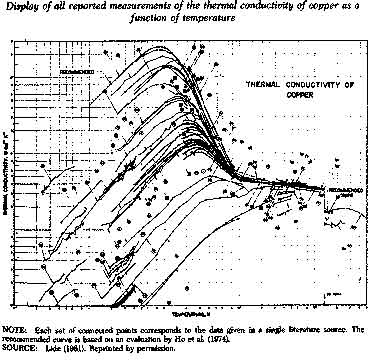(From Surveying Subjective Phenomena, Vol. 1, pp. 14-16)
 As we previously noted, fallibility and error are not confined to the subjective realm, and public misunderstanding of such errors is often quite substantial (as evidenced by the controversy surrounding the population statistics of the 1980 census). Furthermore, just as fallibility of measurement is not limited to the subjective domain, neither is it limited to survey measurements or social statistics. Recent reviewers (Hunter, 1977; Lide, 1981) have used the data presented in [Figure Below] to demonstrate the variability that exists among measurements of such elementary physical phenomena as the thermal conductivity of copper. Commenting on this figure, Hunter (1977:2) noted that ". . .although each analyst measured a physical quality that did not vary with location or time, it is clear that a remarkable variability attended the measurements." Moreover, he concluded (p. 2):
As we previously noted, fallibility and error are not confined to the subjective realm, and public misunderstanding of such errors is often quite substantial (as evidenced by the controversy surrounding the population statistics of the 1980 census). Furthermore, just as fallibility of measurement is not limited to the subjective domain, neither is it limited to survey measurements or social statistics. Recent reviewers (Hunter, 1977; Lide, 1981) have used the data presented in [Figure Below] to demonstrate the variability that exists among measurements of such elementary physical phenomena as the thermal conductivity of copper. Commenting on this figure, Hunter (1977:2) noted that ". . .although each analyst measured a physical quality that did not vary with location or time, it is clear that a remarkable variability attended the measurements." Moreover, he concluded (p. 2):
The variation in attempting to evaluate the same physical constant is obvious. This example is not unusual. Similar plots of thermal conductivity as a function of temperature for approximately 400 common metals and material can be found in a supplement to the Journal (Ho et al. , 1974). Nor is the observed variation in the measurement of "thermal conductivity" unique among physical parameters. . . .
Not only can physical measurements vary wildly, but even well-publicized "discoveries" in the physical sciences have sometimes been shown to be experimental artifacts. For example, between 1963 and 1974 more than 500 articles in journals (including Science and Nature) discussed a supposed new substance: anomalous water or polywater. Although it resembled ordinary water, polywater was alleged to have a greater density, a reduced freezing point, and an elevated boiling point, among other anomalous properties. In the end, however, it was discovered that this "new substance" was nothing more than an impure solution of ordinary water (see Franks, 1981; Eisenberg, 1981).